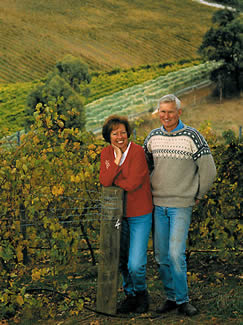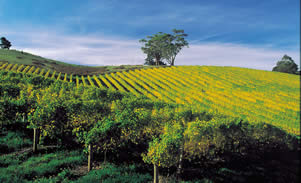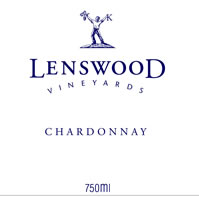|
Dinner with
Annie
Knappstein, of Knappstein Lenswood Vineyards
Roussillon Restaurant, 16 St Barnabas St, London SW1 W8PE
November 2002
| Being a wine journalist involves, among other things,
attending lots of tastings. It’s not unusual to taste more than 100
wines in the course of a day. One famous wine writer even boasted
recently of tasting an almost unbelievable 26 000 wines a year. But
although ' tasting' lots of wines like this is an important
part of the wine hack’s role, it’s nice also to be able to
actually drink wine from time to time. This is why I enjoy winemaker
dinners. Typically, you get a meal in a good restaurant, a chance to
chat informally with a producer, winemaker or owner, and an
opportunity to drink their wines in a leisurely manner. Useful, and
fun.
This time the winery concerned was Knappstein Lenswood
vineyards. Annie Knappstein was in town, and we had dinner at the
impressive Roussillon restaurant in Chelsea. Annie is the other half
of Tim Knappstein (loosely speaking she does the meeting the public bit, he does the
winemaking), who back in the 1970s established Tim Knappstein wines, a
successful winery in South Australia’s Clare Valley.
|

Annie and Tim Knappstein |
Tim and Annie
sold the winery and the business to Petaluma in 1992, along with the
vineyards in 1995. Petaluma dropped the ‘Tim’ from the name, and
the winery is now known simply as Knappstein wines.
But a while before they sold their company, Tim and Annie had already established themselves in a new
vineyard region, Lenswood, in the Adelaide Hills. ‘No one had grown
grapes in Lenswood before,’ Annie explained. ‘It was predominantly
an apple growing area.’ How did they come to move there?
‘We’d never heard of it before, but friends lived there. We
were looking for a cooler climate to grow Sauvignon Blanc and
Chardonnay, and for Tim to explore Pinot Noir. We
went to look at it and then bought in 1981. Our experience with
viticulture had been with Clare, where we planted across the contours. This was well adapted for Clare but wasn’t
suited to Lenswood. The steepness of the slopes meant that the
tractors kept slipping down the hill. The next and subsequent
plantings were planted straight up and down the hills.
We also took good advice from a world famous viticulturalist who got a
few bits of it wrong. We initially planted some Riesling (marginal),
and Cabernet, which is wrong for our area.’
 The current vineyard is in two large bowl shapes, consisting
of the property purchased in 1981 and also an ex-apple orchard next
door, which was bought in 1990. This gave some suitable north-facing
slopes for Pinot Noir. The Knappsteins put in newer clones of Pinot
Noir – earlier they’d only had access to Aussie clones which
weren’t as good. ‘The Burgundian clones have added an extra
dimension’, says Annie. With its decidedly cool climate,
viticulture in Lenswood has to be spot on, or the grapes run the risk
of not ripening properly. But, as these wines here showed, when
producers get it right this is a very exciting region for producing
elegant fine wines. The current vineyard is in two large bowl shapes, consisting
of the property purchased in 1981 and also an ex-apple orchard next
door, which was bought in 1990. This gave some suitable north-facing
slopes for Pinot Noir. The Knappsteins put in newer clones of Pinot
Noir – earlier they’d only had access to Aussie clones which
weren’t as good. ‘The Burgundian clones have added an extra
dimension’, says Annie. With its decidedly cool climate,
viticulture in Lenswood has to be spot on, or the grapes run the risk
of not ripening properly. But, as these wines here showed, when
producers get it right this is a very exciting region for producing
elegant fine wines.
Other producers have now discovered the potential of Lenswood.
Henschke have a property next door, with Geoff Weaver down the road.
Other neighbours include Ashton Hills and Ravenswood Lane.
Altogether the Knappsteins have 26 ha of vines, with a
production in the region of 8500 cases per year. Potential production
is eventually 12 000–15 000 cases. Annie says they can’t afford to
compromise with quality. ‘The best of the vintage goes into bottle,
and the rest is sold in bulk. For example, we sold the entire
production of the 2000 Palatine (their red wine blend) off in bulk.’
They don’t yet have their own winery; instead they have to share
facilities.
Knappstein Lenswood Sauvignon Blanc 2001
Australia isn’t known for its Sauvignons, but with more wines
like this, things could be changing. Lovely full, aromatic crisp nose
with ripe, grassy fruit. Very classy. Good concentration of bright
fruit on the palate. Crisp and fresh, this is very expressive.
There’s a dollop of Semillon (3%) in here, apparently, and the four
blocks of Sauvignon are fermented separately. Very good/excellent
Knappstein Lenswood Semillon 1999
Semillon was Tim and Annie’s first release from their new
project back in 1990. Annie says that they’ve had a lot of
difficulty with it because it is marginal in this vineyard. They did
another in 1991 and then didn’t make a further Semillon until 1995.
They changed the trellising and have learned how to control ripeness
by means of leaf plucking and grape thinning. This wine is 100%
Semillon, half aged in oak and half in stainless steel, with a tiny
bit of malolactic and lees stirring. It has a striking sweet nose of
coconut and vanilla, with some toastiness. The palate is crisp and
fresh with a lovely lemony edge. It’s a very satisfying wine with
some toasty richness and good acidity. Went very well with the lobster
we were served. Very good+
 Knappstein Lenswood Chardonnay 2000 Knappstein Lenswood Chardonnay 2000
Half barrel-fermented, half tank fermented. Only part undergoes
malolactic fermentation. Rounded nutty, toasty nose is quite classy
and savoury. Very savoury, intense, concentrated palate which is
nicely restrained, with good acidity. Quite biscuitty. Very
impressive, with good complexity. Very good/excellent
Knappstein Lenswood Pinot Noir 2000
Annie says that ‘it’s terrifying how much time gets spent on
Pinot. Lots of people say it is fickle; we say it is unforgiving –
you can never cover up your mistakes’. The five clones the
Knappsteins grow are fermented separately small oak, and one and two
ton fermenters, which are plunged four times a day. This wine went
brilliantly with the rich beef topped with truffle-shavings, showing a
lovely complex herbal nose with some sweet ripe fruit and a spicy
streak. Wonderfully expressive. The palate is quite taut, herby and
rich with a spicy, slightly medicinal edge. A wonderfully complex wine
with good acidity and structure, showing some real varietal character.
Excellent
Knappstein Lenswood Palatine 1998
A blend of Cabernet Sauvignon 52%, Merlot 31% and Malbec 17%.
‘We started making this wine in 1997’, explains Annie. ‘Although
we had all three varieties before, our merlot was only ordinary.’
Friends of theirs, Drs Bronte and Mandy Ayres at Loberthal in the
Adelaide Hills, had a love of Petrus and a tax problem, so they
planted a Merlot vineyard 500 yards outside Lenswood on shale. This
gave the Knappsteins the good quality Merlot they needed to make
Palatine. Cabernet is difficult in Lenswood (it’s too cold). The
Knappsteins first did it in 1994, but they didn’t make anything with
it until 1997. In 1998 they took
a new approach. ‘Tim came up with a brilliant idea of doing amarone
on Cab’, says Annie. ‘He picked half the Cab and put it on racks
in apple cold stores for 10-12 days.’
The 1998 Palatine has a sweet tobaccoey and herb nose with a
liqueur-like edge. The palate is ripe but taut and leathery with spicy
rich tannic palate. It’s quite firm and savoury. Rich and intense
with a tea-leaf herby complexity. Boldly flavoured, this is lovely
stuff with no trace of unripeness. Very good/excellent
Overall,
a superb line up of wines, verging on the profound in places. I liked
them all, but if I had to take just one home to dinner tonight it would
be the Pinot Noir. And it was a pleasure to meet the personable Annie
Knappstein, who had to endure a barrage of questions from me!
Stockist information
Uncorked (Tel. 020 638 5998)
The Holland Park Wine Company (Tel. 020 7221 9614)
Noel Young Wines (Tel. 01223 844 744)
Or contact the UK agent: McKinley Vintners (020 7928 7300; info@mckinleyvintners.co.uk)
Back to top
|


 The current vineyard is in two large bowl shapes, consisting
of the property purchased in 1981 and also an ex-apple orchard next
door, which was bought in 1990. This gave some suitable north-facing
slopes for Pinot Noir. The Knappsteins put in newer clones of Pinot
Noir – earlier they’d only had access to Aussie clones which
weren’t as good. ‘The Burgundian clones have added an extra
dimension’, says Annie.
The current vineyard is in two large bowl shapes, consisting
of the property purchased in 1981 and also an ex-apple orchard next
door, which was bought in 1990. This gave some suitable north-facing
slopes for Pinot Noir. The Knappsteins put in newer clones of Pinot
Noir – earlier they’d only had access to Aussie clones which
weren’t as good. ‘The Burgundian clones have added an extra
dimension’, says Annie.  Knappstein Lenswood Chardonnay 2000
Knappstein Lenswood Chardonnay 2000